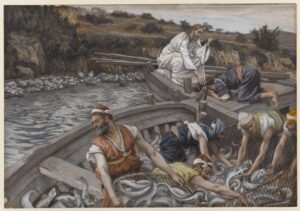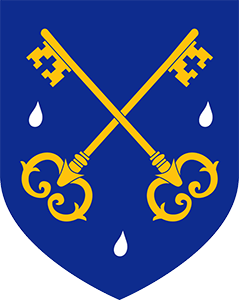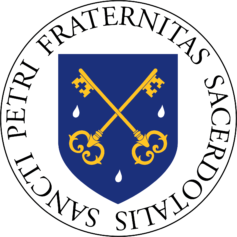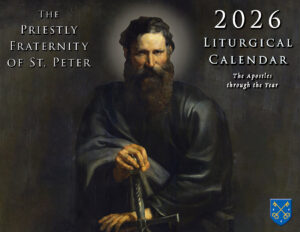St. Peter and the Sea
by Rev. Cav. William Rock, FSSP, SMOCSG

In the fourteenth chapter of the Gospel of Matthew is found the account of St. Peter’s sinking into the sea after walking upon it and his subsequent rescue by Our Lord (14:28-33). Perhaps unsurprisingly, this incident has found its way into the liturgy of the Roman Church which was founded by this same Apostle.
The first time one is most likely to encounter this episode is when it is referenced among the ceremonies of the very Sacrament which makes one a member of Church, that of Baptism. In the first exorcism of the Baptismal ceremony in both the Roman Ritual and the Roman Pontifical, the “accursed and damned one” is commanded by “He Who walked upon the sea and stretched out His hand to the sinking Peter.”1 This is a very fitting reference as immersion, the full submersion of the one being baptized under the water, was the common practice in the early Church.2 It is easy to see symbolized by Peter and Christ the one submerged and the one raising him out of the waters. For just as Christ lifted Peter out of the water thus saving him from death, so does the priest raise the one submerged out of the font saving him from the death of sin and bringing him to a new, supernatural life.
There are two other references to this event in the Roman Ritual, namely in the blessing of a boat (navis)3 and in the solemn blessing of, specifically, a fishing-boat (benedicito solemnis navis piscatoriæ)4 (this second blessing was approved by the Congregation of Sacred Rites on April 10, 1912). In both, it is prayed: “Reach out Thy hand to them [the passengers], Lord, as Thou did to blessed Peter as he walked upon the sea.” This is, of course, a prayer for the safety and protection of those on the boat, that they be guarded against the dangers of the waves and winds which can be encountered while out on the water. The full text of the prayer in which this petition is found is common to both blessings and reads as follows:
Lord, be well disposed to our prayers, and by Thy holy hand bless + this ship [or fishing-boat] and its passengers, as Thou were pleased to let Thy blessing hover over Noe’s ark in the Deluge. Reach out Thy hand to them, Lord, as Thou did to blessed Peter as he walked upon the sea. Send Thine holy angel from on high to watch over it and all on board, to ward off any threat of disaster, and to guide its course through calm waters to the desired port. Then after a time, when they have successfully transacted their business, may Thou in Thy loving providence bring them back with glad hearts to their own country and home. We ask this of Thee who live and reign forever and ever.5

It is interesting that this prayer attributes to God the Son Himself the blessing given to Noe’s ark during the Flood, a reminder that all Three Persons of the Trinity acted together throughout the events recorded in the Old Testament. The request for the Holy Angel mirrors that found in the blessing of a house and in the prayer which accompanies the Asperges at Holy Mass. For those who may be interested, the blessing of a fishing-boat runs several pages and involves the dedication of the boat to a particular titular saint. It is likely that this blessing is meant for a commercial fishing-boat, not a recreational one.
Turning to the Missal, this episode is read as the Gospel (Matt 14:22-33) on the Octave Day of Sts. Peter and Paul (July 6th).6 The collect for this Mass also references this event:
O God, Whose right hand upheld blessed Peter walking upon the waves lest he should sink, and delivered his fellow-apostle Paul when shipwrecked for the third time from the depth of the sea; hear us in Thy mercy, and grant that through their merits we may obtain the glory of everlasting life: Thou Who livest…7
This same oration is found in the Votive Mass of Sts. Peter and Paul recommended for Wednesdays later in the Missal. In this votive Mass, however, the oration is not in harmony with the Gospel reading, which is the same as that read during the Octave (Matt 19:27-29) rather than that of the Octave Day itself. As per usual, the Gospel and oration of the Octave Day are also utilized in the Office of the day.
Lastly, turning to the Breviary, in addition to what has already just been noted, the second antiphon for Vespers and Lauds for the Feasts of the Finding (May 3rd)8 and Exaltation (September 14th) of the Holy Cross unites Our Lord’s saving of St. Peter with the saving power of the Cross:
Save us, O Christ the Saviour, through the might of Thy Cross: Thou Who didst save Peter on the sea, have mercy on us.
A common theme throughout is that this incident is invoked as an expression of God’s power and ability to save from both natural and spiritual peril and confidence that, in accordance with His wisdom, He will so do in favor of his faithful. May the faithful then, when inundated by the winds and waves of this world, imitate St. Peter and cry out for God’s help confident that He will not let a soul which trusts in Him be lost.
Rev. Cav. William Rock, FSSP, SMOCSG was ordained in the fall of 2019 and was invested as an Ecclesiastical Knight of the Sacred Military Constantinian Order of St. George in the summer of 2025. He currently resides at the FSSP Canonical House of St. Casimir in Nashua, NH, and ministers at St. Stanislaus parish.
In support of the causes of Blessed Maria Cristina, Queen, and Servant of God Francesco II, King
- Rituale Romanum [1957], Titulus II. Translation adopted from: Manus, Frederick. Parish Ritual. (New York: Benziger Brothers, Inc., 1962), p. 5.
- The old Catholic Encyclopedia, s.v. “Baptism.”
- Rituale Romanum [1957], Titulus IX – Caput 8.5.
- Rituale Romanum [1957], Titulus IX – Caput 8.6.
- Translation adapted from the Weller translation provided online by EWTN (2, VIII, 19 and 20).
- This octave was removed from general observance by Pope Pius XII in 1955 with the decree Cum hac nostra aetate. Perhaps the day will come when this octave is restored, fittingly, for the use of the Priestly Fraternity of St. Peter.
- Translation adopted from the Saint Andrew Daily Missal (St. Paul: The E. M. Lohmann Co., 1940), p. 787. Original Latin: Deus, cujus déxtera beátum Petrum, ambulántem in flúctibus, ne mergerétur, eréxit, et coapóstolum ejus Paulum, tértio naufragántem, de profúndo pélagi liberávit: exáudi nos propítius, et concéde; ut, ambórum méritis, æternitátis glóriam consequámur: Qui vivis.
- This feast was also removed from general observance by Pope John XXIII, but its Mass can still be celebrated on May 3rd as a votive.
October 6, 2025









